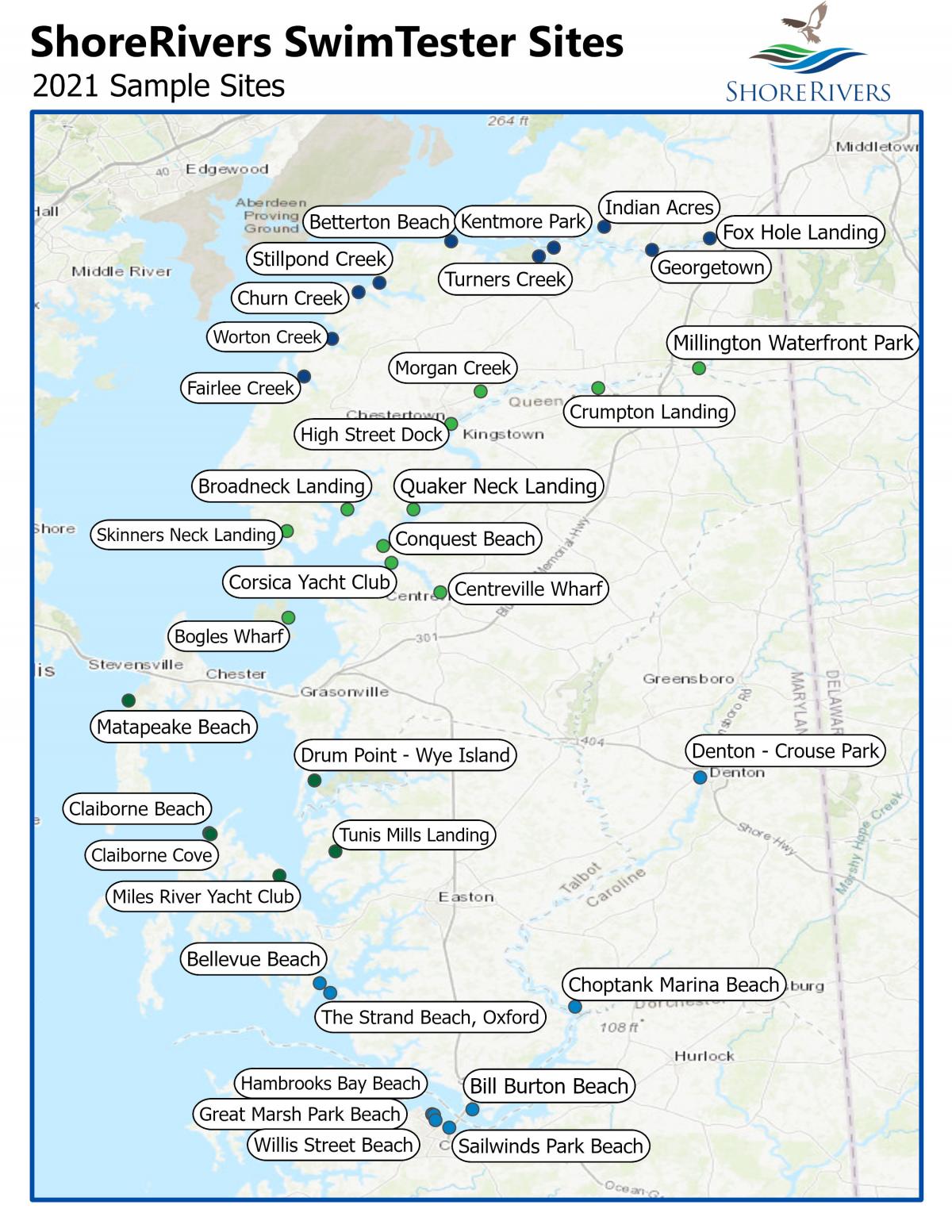This summer, ShoreRivers monitored bacteria levels at 32 sites around the region, providing a critical public health service for communities and identifying pollution hotspots for future restoration efforts. A team of citizen scientists called “SwimTesters” volunteered their time to test these sites weekly from Memorial Day through Labor Day, and generous site sponsors covered a portion of the sampling costs.
SwimTesters monitor for enterococci bacteria at popular public access locations, marinas, yacht clubs, and town piers. The program follows EPA’s standard protocols for collecting and analyzing samples and uses a pass/fail system to determine if bacteria levels are safe or unsafe for swimming. View the results at theswimguide.org and get updates during swim season by following #SwimmableShoreRivers or your local Riverkeeper’s page on social media. By collecting, analyzing, and distributing data on bacteria levels in a river, ShoreRivers aims to provide the public with the information needed to make educated decisions about contact with the water.
 The results from the 2021 SwimTester season show that bacteria levels vary based on location, land use, and weather; making systematic, scientific analysis vital. Major rain events are almost always connected to spikes in bacteria levels. Of the 32 sites monitored by ShoreRiversSwimTesters this year, seven sites failed to meet EPA’s threshold for safe water contact more than 50% of the time. These sites are located on the Choptank River: Crouse Park in Denton and Willis Street Beach in Cambridge; in Eastern Bay: Broad Cove near Claiborne; and on the Chester River: Millington Waterfront Park, Morgan Creek Landing, and Centreville Wharf.
The results from the 2021 SwimTester season show that bacteria levels vary based on location, land use, and weather; making systematic, scientific analysis vital. Major rain events are almost always connected to spikes in bacteria levels. Of the 32 sites monitored by ShoreRiversSwimTesters this year, seven sites failed to meet EPA’s threshold for safe water contact more than 50% of the time. These sites are located on the Choptank River: Crouse Park in Denton and Willis Street Beach in Cambridge; in Eastern Bay: Broad Cove near Claiborne; and on the Chester River: Millington Waterfront Park, Morgan Creek Landing, and Centreville Wharf.
Multiple years of consistent bacteria monitoring have highlighted those sites that frequently show elevated levels of bacteria, potentially indicating a chronic source of bacteria pollution. Potential chronic sources of bacteria include failing septic systems, overflows or leaks from wastewater treatment plants, waste from animal farms, or manure fertilizer. Acute sources of bacteria pollution include overflows from wastewater treatment plants and pet or wild animal waste.
ShoreRivers will next focus on discovering the source of bacteria pollution at sites that fail more than 50% of their tests in a season. Riverkeepers are currently exploring partnerships and innovative technologies to help identify specific sources of bacteria pollution, including DNA tracking, which would identify a specific animal group(human, bovine, avian, canine, etc.).
For the 2022 bacteria monitoring season, ShoreRivers still needs sponsors for 15 sites. Site sponsorship allows ShoreRivers to redirect general funds toward source tracking programs for impaired areas and to activate new sites from the waitlist. The cost to sponsor a site is $40 per week or $640 for an entire season is $640. Anyone can be a sponsor—individuals, families, organizations, or communities. The more bacterial data gathered on the Sassafras, Chester, Miles, Wye, and Choptank Rivers, the Bayside Creeks, and Eastern Bay, the clearer ShoreRivers’ path will be to targeted restoration efforts in our local watersheds.
Clean water is an essential right for everyone, and everyone deserves to know if the water is safe for them and their families to access. For more information, visit shorerivers.org/swim or email your local Riverkeeper to become a site sponsor today!
ShoreRivers protects and restores Eastern Shore waterways through science-based advocacy, restoration, and education.
shorerivers.org



Write a Letter to the Editor on this Article
We encourage readers to offer their point of view on this article by submitting the following form. Editing is sometimes necessary and is done at the discretion of the editorial staff.